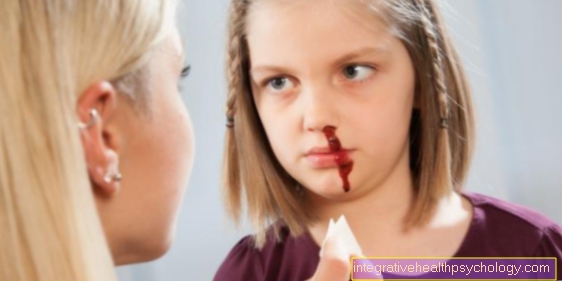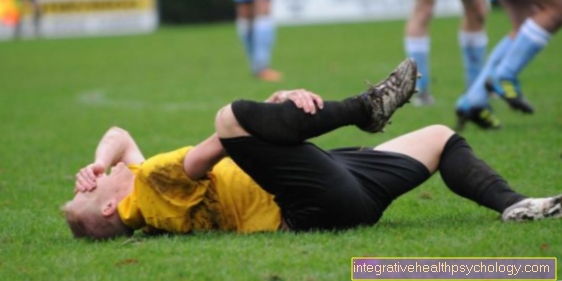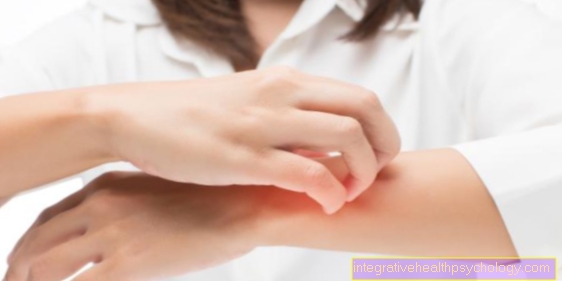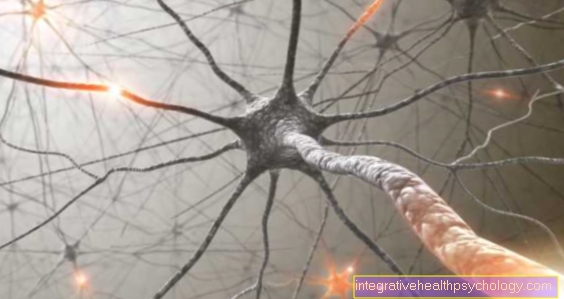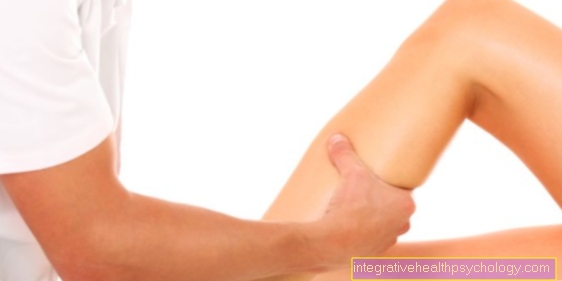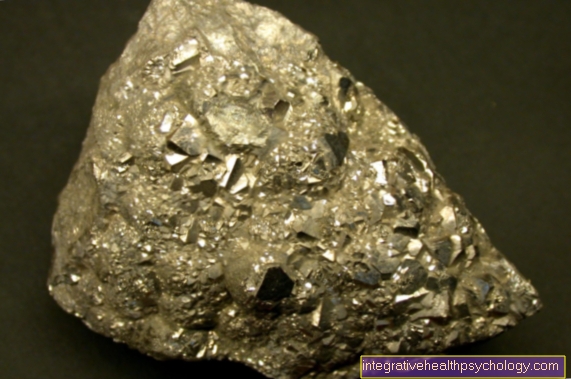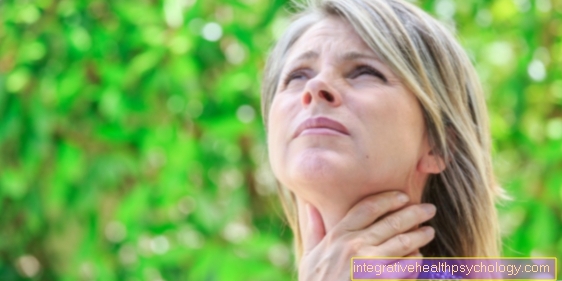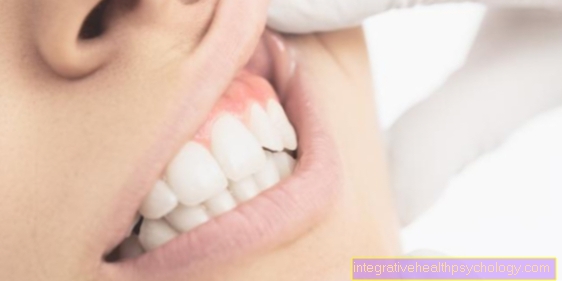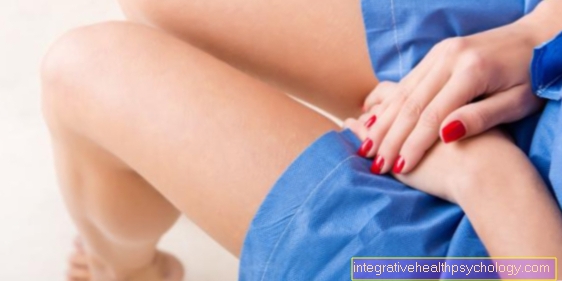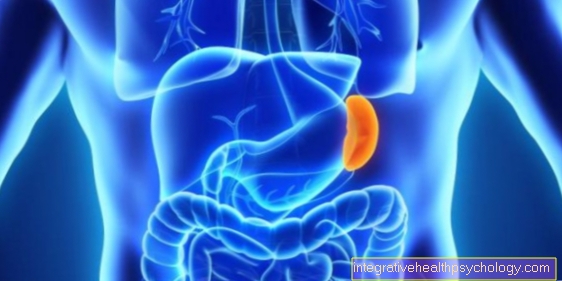Growing pains on the foot - is it normal?
Definition - What are growing pains on the foot?
Growing pains are a very vaguely defined clinical picture. They occur in children who are still growing. Typically, they start suddenly at night and wake the child up. Most of the growing pains are found in the legs. The knees and thighs are most affected.
But growing pains in the foot can also occur. Often the main pain in growing pains is in the ankle. Another characteristic feature is that the growing pains usually appear on both sides.
For general information, also read: Growing pains

Causes of the growing pains on the foot
As well as a precise definition of the clinical picture "growing pains in the foot", one misses the scientific evidence of causes. Therefore, so far only speculations can be made about the origin of the disease and the pain. The theories include short-term misalignments and, above all, muscular malpositions that arise from somewhat uneven bone growth.
Overmobility of the joints is also suspected to be the cause, since the stabilizing ligament apparatus sometimes grows faster than the muscles and bones belonging to the joint. This results in the lower legs and feet becoming fatigued more quickly in many children.
Growing pains are assumed if the child's pain is not due to an illness and the affected child is in the growth phase. A detailed diagnosis is therefore crucial in order to exclude possible diseases and to be able to differentiate the growing pains from them.
Can growing pains also signal a growth disorder? You can find more information on the question and much more at: Stunted growth
Differentiation from other diseases
Calcaneal apophysitis
Apophysis calcanei is the place on the heel bone (os calcaneum) where the Achilles tendon attaches. This area is exposed to a lot of stress, especially in growing children. The stress is increased by physical activity, which is why active children and adolescents are most often affected by the disease. Excessive stress can cause the tendon attachment to become soft. The symptoms typically occur immediately after exercise and are noticeable as tenderness on the area.
Inflammatory processes in the apophysis are less common. This leads to pain, swelling, reddening, overheating and a reduced functionality of the Achilles tendon and thus also of the calf muscle, which is attached to the foot via this tendon. A worsening of the pain while walking is characteristic.
The therapy of apophysitis calcanei consists of the administration of painkillers and the cooling of the affected heel. In addition, exercise should be avoided for about four to six weeks. If you still do not notice sufficient improvement in symptoms, you can also wear a heel wedge. This tilts the foot a little forward and relieves the Achilles tendon.
Calcaneal apophysitis usually first occurs on one foot, but can quickly cause problems in the other foot as well. A gentle posture of the first affected foot and the associated additional stress on the other foot lead to the same complaints there. Ultrasound of the Achilles tendon is usually sufficient for a detailed diagnosis.
You can take a closer look at the condition with the help of the following article: Calcaneal apophysitis
Köhler's disease I
The disease Köhler's disease I describes necrosis (i.e. death) of parts of the scaphoid bone on the foot. Small vascular occlusions mean that the bone is not permanently supplied with sufficient blood and therefore with nutrients. As a result, some of the cells die.
Due to its inconspicuous symptoms, the disease is often only discovered when the first consequential damage, such as the onset of osteoarthritis of the tarsal bone, has already occurred. Typically, Köhler's disease I affects boys between the ages of three and eight years.
How dangerous is Köhler's disease? For the answer, read: Köhler's disease I and II
Köhler's disease II
Köhler's disease II, like Köhler's disease I, involves tissue destruction from the bones of the foot. In contrast to Köhler's disease, however, the metatarsal bones are affected. The cause is small vascular occlusions, which lead to an insufficient supply of the bones. While type I is more common in boys, Köhler's disease II is typically found in young girls.
Duration and prognosis of growing pains in the foot
The individual pain attacks usually only last for a few minutes to hours and usually occur at night. The growing pains in the foot can occur very regularly over several weeks to months. Recurring attacks over a number of years can also occur.
The prognosis for growing pains on the foot is very positive. The symptoms usually disappear completely when the child is (almost) fully grown. In order to prevent the pain from becoming chronic, which usually also has a psychological component, the complaints and pain of the affected children should be taken seriously at all times.
Treatment of growing pains in the foot
Since the causes of the growing pains in the foot have not yet been clarified, a causal therapy is currently not possible. Instead, only the symptoms can be treated.
The pain can be temporarily treated with painkillers such as paracetamol or ibuprofen. However, permanent therapy with painkillers is by no means advisable. The medication should be taken for a maximum of ten days a month, and attention should also be paid to the maximum daily dose. This is based on the children's body weight. If these limit values are not observed, the painkillers can permanently damage the liver and / or kidneys of the children.
In the long term, the best therapy for growing pains in the foot is to provide parents and children with detailed information about the harmlessness of the pain. In this way, many fears that are associated with recurring foot pain can be reduced. Usually this also improves the symptoms in the affected children.
During an acute attack of pain, it is usually helpful to apply a heat pad to the affected area. This leads to a relaxation of the muscles and thereby reduces the pain. A massage can also reduce tension and thus alleviate the symptoms.
It is also important that the child's complaints are taken seriously by the parents and treating physicians. In acute pain, just good persuasion and taking the pain seriously can reduce the discomfort.
You might also be interested in: How can I strengthen my child's immune system?
Diagnosis of growing pains on the foot
Growing pains are a typical diagnosis of exclusion when there is pain in the foot. So it is only asked if no other cause for the pain in the foot can be found.
Other causes of pain can be injuries and infections, for example, but rheumatism and tumors can also trigger similar symptoms. Such diseases can be ruled out with the help of a physical examination as well as various examination methods. Rheumatic diseases can be ruled out with a blood test. Tumors and infections of bones are visible in the X-ray. Smaller injuries and infections of soft tissues can be excluded in the MRI.
Here you will find an overview of the diseases affecting the foot: Foot disorders
Concomitant symptoms
In addition to the growing pains on the foot, pain can also be felt in other parts of the body. The growing pains usually affect both feet, and it is not uncommon for the pains to appear in the calves at the same time. Those who already suffer from growing pains in their feet can also experience growing pains in their knees, thighs and arms.
The growing pains in the joints and muscles of the arms and legs are often accompanied by abdominal pain or headaches. It has not yet been clarified whether these are more the expression of psychological discomfort or whether there is a specific connection with substances that trigger pain. Since the growing pains often occur at night and the children are woken up by it, fatigue often joins the symptoms. This, in turn, can make the headache worse. In extreme cases, concentration disorders and a decline in performance are the result.
Children who do not feel that their pain is taken seriously or whose complaints are not adequately addressed can also react very anxiously and insecurely to the symptoms. If you experience more often that you wake up at night with pain and are not well taken care of, sleep disorders and fears before going to bed can develop. However, these accompanying symptoms can easily be prevented.
When should one worry about the child? Emergency with the child






